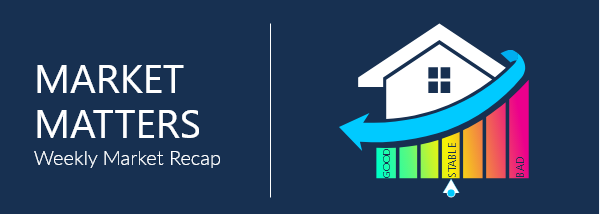Market Matters

We have seen a rare rally this week, as the 10-year went all the way up to 3.20%, and then traveled all the way to 2.81, before stabilizing at 2.85%. Risk assets had a rough week, specifically U.S. Stocks and crypto assets, which had a risk off sentiment as those assets sold off and bonds rallied as investors flew to safer assets. With the sell-off in U.S. equities this week, along with the Fed raising rates and giving forward guidance they will continue to raise rates, it appears financial conditions are tightening. The question is when will they be tight enough to rein in inflation, and will the Fed be able to achieve a soft landing. Best to be defensive here, as there is still little conviction in the markets and it wouldn't be surprising if we tested the 2018 highs on the 10-year at 3.26%
 Initial Jobless Claims
Initial Jobless Claims
Initial Jobless Claims rose by 1k to 203k for the week ending May 7th. The 4-week moving average rose 4.3k to 192.8k, the highest since the week of March 5th. Continuing claims, which lag by a week, fell -44k to 1.343mln and are now at their outright lowest levels since the first week of 1970. They're also well below pre-pandemic levels, which average about 1.798mln in February 2020. The sum of claims in all programs fell by -38k to 1.44mln, the lowest since October 2019.
 Consumer Price Index
Consumer Price Index
CPI rose .3% on headline in April vs. the prior 1.2% increase back in March. Looking YoY, the all-items headline index increased by 8.3%, down from the 8.5% reported for March. Looking at the core measure, which strips out food and energy components, we see a MoM increase of .6%, with the YoY rate at 6.2%, down from a prior 6.5%. Within the data, shelter gained .5%, rents up .6%, food up .9%, with energy down -2.7%. Strong growth was seen in the airline fares index, up 18.6% this month, which was the most significant one-month increase since the measure began in 1963. Another large contribution to the recent rise in prices has been auto sales. This month, while used vehicle prices fell -.4%, new vehicle prices rose by 1.1%. Prices rose 22.7% and 13.2% for the two, respectively, over the past year. Finally, and probably one of the most important results here is that real wages adjusted for inflation declined by -.1% on the month despite the nominal increase of .3% in average hourly earnings seen from the last jobs report. Over the past year, real earnings have dropped -2.6% even though average hourly earnings are up 5.5%
 Producer Price Index
Producer Price Index
PPI in April rose .5% vs. the prior 1.6% print back in March, and vs. February's 1.1%. Stripping out food and energy, wholesale prices rose by .6% in April, -.3% down from March's .9% increase. Looking YoY, headline PPI was up 11.0%, while the core was at 6.9%. Within the report, the index for final demand services showed no change after March's 1.2%. Similarly, with CPI, the prices for truck transportation rose 4.4%, and prices for motor vehicles and equipment grew .8%. The energy final demand rose 1.7% in April, while the final demand food rose 1.5%. The index for gasoline dropped by -3.2%, which was also a similar trend in CPI's energy index.
 Mortgage Applications
Mortgage Applications
The MBA weekly mortgage applications index increased by 2.0% for the week ending May 6th. Purchase applications rose 5.0% and were -8.0% lower than the same week last year. Refinance applications declined by -2.0% and were -72.0% lower vs. the same week a year ago. "The increase in mortgage applications last week was driven by a strong gain in application activity for conventional and government purchase loans, even as mortgage rates rose to their highest level -- 5.53 percent -- since 2009. Despite a slow start to this year's spring home buying season, prospective buyers are showing some resiliency to higher rates. Purchase activity has now increased for two straight weeks," said Joel Kan, MBA's Associate Vice President of Economic and Industry Forecasting. "More borrowers continue to utilize ARMs to combat higher rates. The share of ARMs increased to 11 percent of overall loans and to 19 percent by dollar volume." Added Kan, "The rapid rise in mortgages rates continues to hit the refinance market, with activity 70 percent below a year ago. Most homeowners refinanced to lower rates in the past two years."

